Rock Crab - Pacific
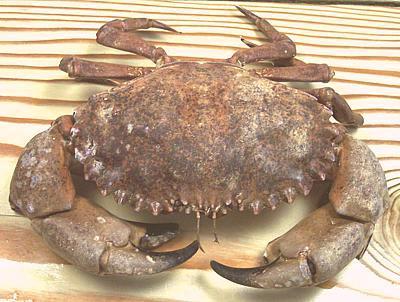 [Cancer Productus]
[Cancer Productus]
A heavy, hard shelled bottom crab with a bad disposition and claws so
strong they can pinch right through heavy neoprene gloves. They live in
rocky areas along the Pacific coast of North America from Alaska to Baja
and can grow to nearly 8 inches wide across the carapace. The photo
specimen was a male 6 inches across and weighing 1# 13oz (1.8 pounds).
This crab is not to be confused with the very common Atlantic rock
crab (Cancer irroratus) which is much smaller and lighter of
build or the small, fast moving Australian red rock crab
Plagusia chabrus.
More on Crabs.
This crab has tender flesh with good crab flavor. It's best as an
"eat from the shell" crab because the flakey flesh is a bit difficult to
remove. Serve it in halves as shown below.
Yield is very low with a 1 pound crab yielding 2.6 ounces of crab meat
(16%) but that's better than some other crabs. The claws and claw arms
yielded 1.3 ounces and the rest of the crab 1.3 ounces. About 1/2 the
claw arm flesh was in the claw itself.
Some people just boil the crabs whole but I prefer to clean them before
cooking to minimize tainting the body flesh. With a little practice cleaning
goes quickly.
| 1 |
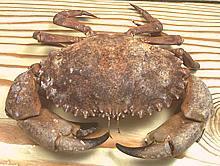
|
Sedate your crabs - they are not going to be at all cooperative otherwise.
The claws of this crab are extremely powerful and you don't want to get
pinched. Sedate them by giving them a good long soak in a tub of ice water
(with plenty of ice). They'll still be moving but very sluggish and won't
be able to pinch. Being sedated also makes the following step easier on
the crab.
|
| 2 |
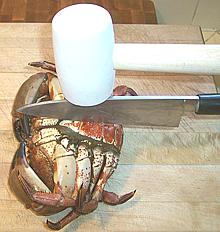
|
With the crab on its back place a strong kitchen knife down the centerline
and hit it with a soft faced mallet to drive it into the crab. This will
kill the crab, not instantly but very quickly. If you
want the shell intact for stuffing or some other use, make sure the point
of the blade doesn't project much over the front edge of the crab and don't
pound too hard. The knife should go about half way through. If needed,
finish the cut after removing the apron.
|
| 3 |
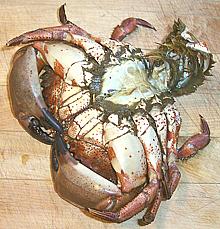
| Turn the crab over, bend back the apron and snap it off.
The apron of a female crab will be wide as shown in the photo, the apron
of a male will be very narrow and pointy. Finish splitting the crab if
needed..
|
| 4 |
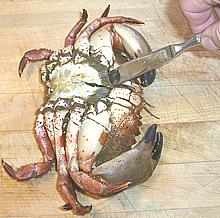
|
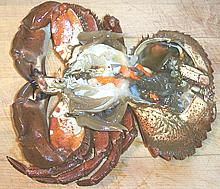 With a butter knife, insert in the crack under the claw joint and pry up
each half of the split chassis to free it from the shell. Bend the shell
back to completely free the chassis. Most of the gooky stuff will stay
with the shell.
With a butter knife, insert in the crack under the claw joint and pry up
each half of the split chassis to free it from the shell. Bend the shell
back to completely free the chassis. Most of the gooky stuff will stay
with the shell.
|
| 5 |
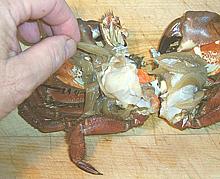
|
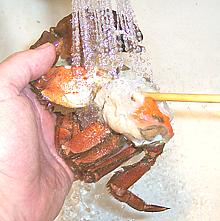 Pull off the gills (known as "dead man's fingers") and wash under running
water - anything with any color needs to be removed from the inside. A
chopstick can help you get stuff out of the cavities leaving only
translucent white flesh. Use kitchen shears to cut away any extraneous
pieces of shell.
Pull off the gills (known as "dead man's fingers") and wash under running
water - anything with any color needs to be removed from the inside. A
chopstick can help you get stuff out of the cavities leaving only
translucent white flesh. Use kitchen shears to cut away any extraneous
pieces of shell.
|
| 6 |
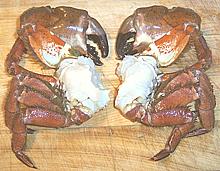
|
You now have a completely cleaned crab chassis in two halves, with legs
and claws attached to each half - all ready to cook by whatever means you
please.
|
sf_cbrockz 060917 - www.clovegarden.com
©Andrew Grygus - agryg@clovegarden.com - Photos
on this page not otherwise credited © cg1
- Linking to and non-commercial use of this page permitted




 With a butter knife, insert in the crack under the claw joint and pry up
each half of the split chassis to free it from the shell. Bend the shell
back to completely free the chassis. Most of the gooky stuff will stay
with the shell.
With a butter knife, insert in the crack under the claw joint and pry up
each half of the split chassis to free it from the shell. Bend the shell
back to completely free the chassis. Most of the gooky stuff will stay
with the shell.

 Pull off the gills (known as "dead man's fingers") and wash under running
water - anything with any color needs to be removed from the inside. A
chopstick can help you get stuff out of the cavities leaving only
translucent white flesh. Use kitchen shears to cut away any extraneous
pieces of shell.
Pull off the gills (known as "dead man's fingers") and wash under running
water - anything with any color needs to be removed from the inside. A
chopstick can help you get stuff out of the cavities leaving only
translucent white flesh. Use kitchen shears to cut away any extraneous
pieces of shell.

 [Cancer Productus]
[Cancer Productus]